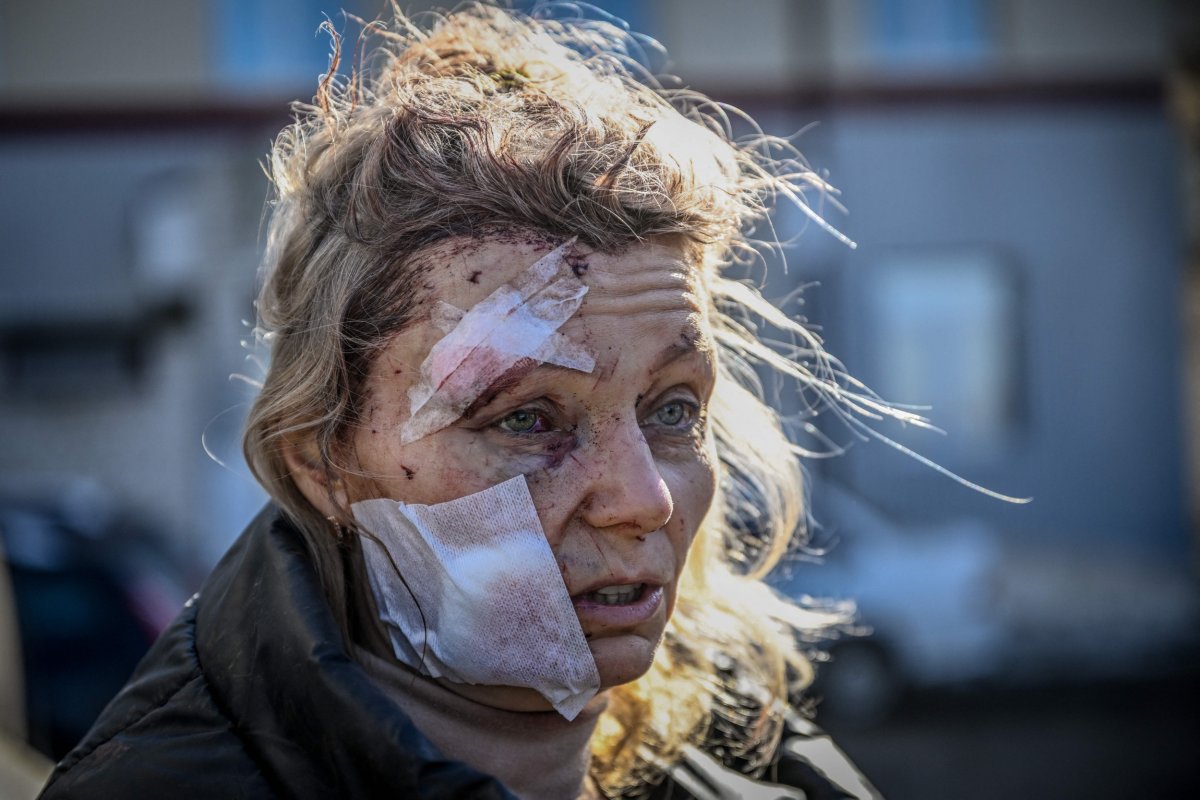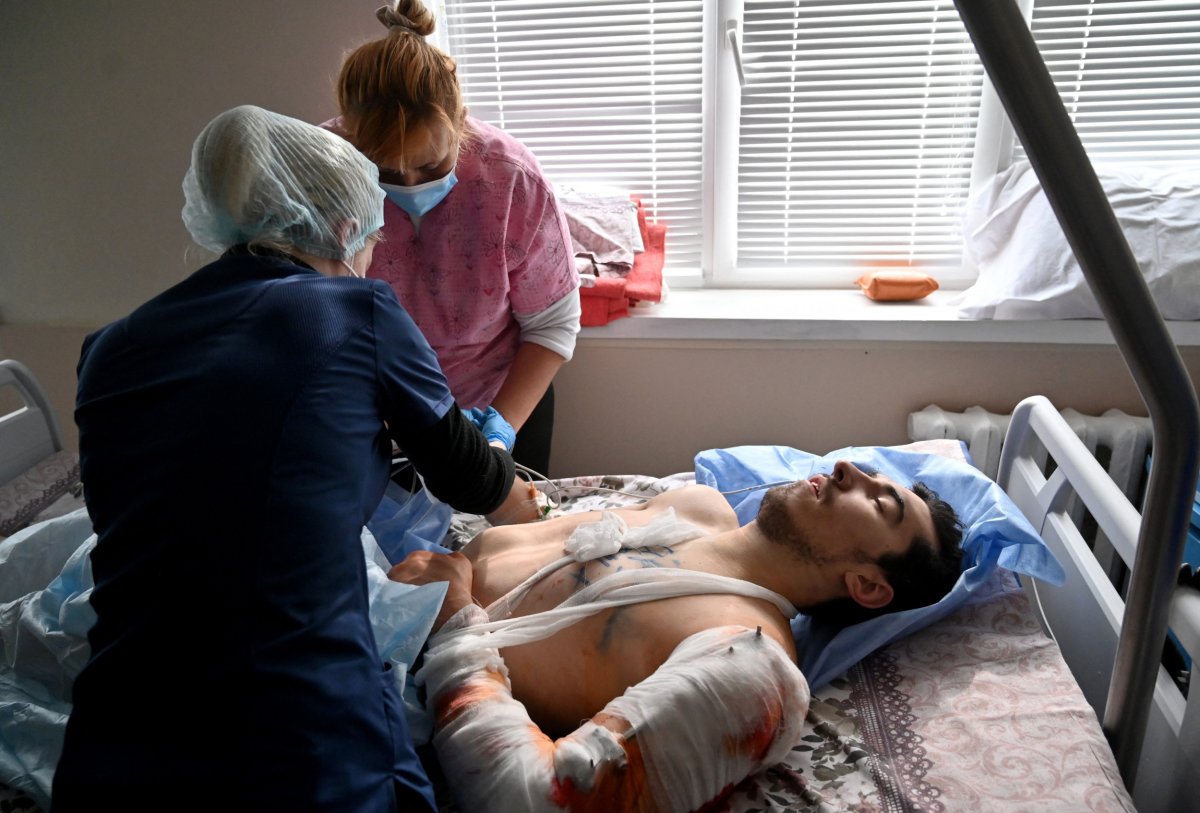
The number of civilian casualties in Ukraine is nearly five times what the United Nations has reported, three people involved in the analysis tell Newsweek.
Three senior military officers say U.S. intelligence has established a number of special cells—at the Pentagon, at the Defense Intelligence Agency and at U.S. European Command—to methodically track the Ukraine war, both for situational awareness and to document Russian violations of the laws of war. The three are active duty officers. One is involved in the actual cell; the other two are briefed on the results as part of their work on Pentagon staffs. The officers requested anonymity in order to discuss classified material.
U.N. human rights offices on Monday confirmed 406 civilian deaths and 801 injuries since the Russian invasion of Ukraine on Feb. 24. The U.N. says that the number of civilian casualties "is likely to be much higher" as more information comes in.
U.S. intelligence estimates put that number closer to 2,000 deaths and as many as 10,000 injured in 11 days of fighting.
"Civilian casualties are being observed in all regions and consistent throughout the country given the levels of firepower," one of the officers tells Newsweek.
"We are collecting evidence of possible war crimes, human rights abuses, and violations of international humanitarian law," a White House National Security Council official told Reuters on Monday.
On Friday, White House press secretary Jen Psaki said the United States has begun an internal review "to collect evidence and data of the targeting of civilians [and] of the reported use of horrific weapons of war on the ground in Ukraine."

The first officer says that shifts in where casualties have occurred have been due to the progression of the Russian ground campaign. He describes three phases so far. The eastern and southern regions suffered the greatest number of civilian casualties in the first week of fighting, particularly in Donetsk and Luhansk regions.
Starting about March 1, the five encircled cities—Chernihiv to the north of Kyiv, Konotop and Sumy to the east, Ukraine's second largest city Kharkiv on the eastern Russian border, and Mariupol in the south—started experiencing the greatest number of deaths as the Russian advance stalled and Russian forces grew more impatient.
But since Friday, the cluster of towns and villages northwest of Kyiv, all on the western side of the Dnieper River—Hostomel, Bucha, Vorzel and Irpin—are suffering the brunt of the fighting. There, Ukrainian defenses have been the most fierce.
Russian forces are "increasing bombardments" of the major Ukrainian cities, as well as Mykolaiv and Mariupol in the south, a senior U.S. defense official told reporters on Monday.
"We don't have a perfect correlation between what we're observing in terms of damage and actual numbers," a second of the senior officers tells Newsweek. In many destroyed civilian structures, the officer says, civilians are hiding in shelters and basements. And the population distribution has significantly changed as civilians flee in front of Russian troops. Many of the civilian deaths that have been observed or been reported at the local level, the officer says, may have also involved civilians involved in Ukrainian defense. They will probably be counted as combatants once more information is obtained.
On Twitter Monday, Mykhailo Podoliak, advisor to President Volodymyr Zelensky, and the lead Ukrainian negotiator with Russia, said that some 1,500 civilian residences and apartment buildings have been damaged by Russian attacks, plus some 202 schools and 34 hospitals.
The U.S. estimates that Russia has captured 24 towns and villages since the beginning of fighting. Advance elements of Putin's forces have also entered the suburbs (and even the central areas) of the five encircled cities, where they have bombed government, military and civilian infrastructure targets.
"We've certainly noticed increases in what we call long-range fires, bombardments, rocket attacks, artillery, as well as missile strikes, and we do assess that these strikes are hitting civilian targets, infrastructure, residential areas," the senior U.S. defense official said Monday.
But he said that it was "not clear" whether the Russians were hitting civilian targets deliberately or if the damage was a "result of imprecision."
On Friday, Russian President Vladimir Putin blamed Ukraine for civilian casualties, both in moving military equipment into civilian areas and, he alleged, in using civilians as human shields.
U.S. officials dismiss this as disinformation, saying that there is no evidence of either claim.
The U.S. intelligence effort to identify and document Russian attacks and war crimes is derived mostly from satellite imagery which is then matched with on-the-ground reporting and social media posts. The geospatial intelligence effort, the third intelligence officer tells Newsweek, allows hundreds of imagery interpreters and analysts to pool their observations, all of the analysis tied back to high-fidelity maps of Ukrainian towns and cities.
Civilian casualties and harm in Ukraine, the third officer says, is also analyzed in aggregate: that is, showing patterns of attacks. For instance, one of the officers says, if Russian ground forces are deployed north of a city or town and an east-west line of damage appears, it is indicative of batteries of guns and rockets fired at range, and probably for effect. "The patterns don't lie," the officer says.

In addition, Vladimir Putin's nuclear threat means that every Russian missile launch (there have been about 650 so far) is closely watched from ignition through detonation. Within seconds, the United States is able to determine the prospective target of attack.
Almost all of the long-range missile attacks have been shot at Ukrainian airfields and military bases, the senior officers all say. But close to 30 percent of the long-range attacks have failed, either because they have been shot down by Ukrainian defenders, because of technical failure, or human failures by the operators.
"We observe significant civilian damage as a result of objects falling from the sky," the intelligence officer says. That includes missiles and rockets, aircraft and helicopters that have been shot down, and shrapnel and pieces of weapons falling in urban areas.
U.S. officers also confirm that Russia has been using cluster bombs in their attacks—weapons that are prone to lesser accuracy and threaten the civilian population because of high number of "dud" bomblets.
On Monday, U.K. defense intelligence said that Russia was "probably" targeting the civilian communications infrastructure in a serious way for the first time. "Ukrainian internet access is also highly likely being disrupted as a result of collateral damage from Russian strikes on infrastructure. Over the past week, internet outages have been reported in Mariupol, Sumy, Kyiv and Kharkiv."
Though utilities—electricity, gas and heating, and water—have been lost in many of the front-line locales, U.S. intelligence analysis concludes that Russia has not undertaken any kind of methodical campaign to disable civil infrastructure. The Operator of the Gas Transmission System of Ukraine said Monday that hundreds of thousands of consumers were left without gas supply due to the fighting.
"Our analysis indicates that almost all of the attacks [artillery, missiles, and aircraft attacks] have been in front of Russian ground troops to support ground operations," one of the three senior officials says. "There is no 'strategic' air campaign that we can see."
Ken Roth, executive director of the non-profit organization Human Rights Watch tells Newsweek that the laws of war prohibit attacks on both civilians and civilian objects. "Attacks on civilian objects can kill or injure civilians immediately, if civilians are present, and harm them over time by destroying institutions that they depend on, such as hospitals, schools, and housing," Roth says.
He could not speak directly to either U.N. or U.S. casualty estimates, but says "attacks that are deliberate, indiscriminate or disproportionate violate the laws of war.
"An attack that suffers from a technical failure can still be determined to violate international humanitarian law, but there is less likely to be the mens rea (criminal intent) necessary for it to be a war crime," he says. "If the issue is that soldiers are poorly trained but still ordered to fire weapons, then the command responsibility of those giving the orders comes into play for ordering attacks that are foreseeably indiscriminate."
The senior officers who spoke to Newsweek say that no war crimes per se have been identified connected to the conduct of the war. Intent, they agree, will be a key issue in ascribing blame on the battlefield.
"It's only going to get worse as the fighting continues and more information comes in," says the first senior officer. Russia has bypassed cities because of the amount of resistance they've faced, the officer says, not out of any desire to limit damage.
"No one in Russia is twisting into a pretzel to avoid civilian deaths," the officer says. "We're not yet even seeing the worst of it."
Uncommon Knowledge
Newsweek is committed to challenging conventional wisdom and finding connections in the search for common ground.
Newsweek is committed to challenging conventional wisdom and finding connections in the search for common ground.
About the writer
William M. Arkin is an award-winning journalist and best-selling author of more than a dozen books on national security issues. ... Read more
To read how Newsweek uses AI as a newsroom tool, Click here.






 Subscriber content
Subscriber content